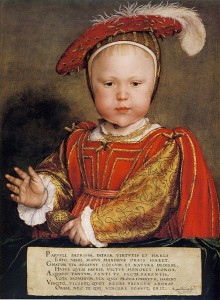On Monday, 15 October 1537 Prince Edward (later Edward VI) was christened in a midnight ceremony in the Chapel Royal at Hampton Court Palace (Weir, pg. 368).
Henry VIII had waited his entire adult life for a legitimate heir to the Tudor throne and so was not about to let anything harm the young prince. Weir writes of how he ordered,
“Every room, hall and courtyard in the Prince’s apartments was to be washed down with soap and swept daily. Everything that came near the child – clothing, bed-linen, toys –was to be scrupulously clean.” (Pg. 368)
This fear of hazards and a looming risk of plague meant that the numbers attending the christening were restricted, yet nearly 400 people attended the momentous occasion 473 years ago.
Although Jane Seymour had endured a difficult and long labour she was well enough to receive guests in her apartments before the ceremony commenced. There she waited, a picture of regality, lying on her bed of crimson damask lined with cloth of gold, her blonde hair loose around her shoulders and wearing a crimson mantle edged with ermine (Weir, pg. 369). The King, her husband, was by her side supporting his beloved wife that had fulfilled her duty and delivered him a son.
In the absence of the Marchioness of Dorset, who was exiled at Croydon owing to possible infection with the plague (Fraser, pg. 279), the Lady Exeter was given the honour of carrying the baby in procession through the corridors of Hampton Court with the support of Norfolk and Suffolk. Edward’s uncle, Thomas Seymour, held the canopy over the baby’s head and Edward Seymour held something else of great importance –the four-year old Lady Elizabeth. Although only young, Elizabeth was given the job of holding the chrisom-cloth (Starkey, pg. 607). The King chose Archbishop Cranmer, Norfolk, Suffolk and the Lady Mary as godparents. The Archbishop baptised the Prince and proclaimed him heir to the King after which he was led back to the Queen’s apartments with much ceremony. Weir writes of how:
“This time, Elizabeth walked, holding Mary’s hand. Jane took her son and gave him her blessing, then the King gathered him into his arms and, with tears of joy streaming down his face, blessed Edward in the name of God, the Virgin Mary and St George. The Prince was then carried off by the Duchess of Suffolk to his own apartments, followed by his household of 400 persons.” (Pg. 369)
Once all present had enjoyed some light refreshments, “hippocras and wafers for the nobility, bread and sweet wine for the gentry” (Weir, pg. 369), they kissed the hands of the King and Queen and departed.
Queen Jane Seymour had played her part and performed her duties so well that no one had suspected that she was ill but only nine days later she would depart this world leaving little Edward like his two half-sisters –motherless.
I cannot help but wonder at what Thomas Boleyn, who was also in attendance, would have been thinking watching the ceremony. I imagine that he would have remembered Elizabeth’s lavish christening that had taken place only four years before. Cranmer was also Elizabeth’s godfather and many of those in attendance at Edward’s christening had taken part in Elizabeth’s. Was he picturing his daughter, Queen Anne Boleyn, lying robed in her great French bed, receiving guests with the King at her side? Was he thinking of his handsome and robust son, George, proudly fulfilling his role as uncle?
Perhaps Thomas Boleyn was not a melancholy man but I dare say that he would have remembered the 500 torchbearers that had accompanied baby Elizabeth back to her mother’s loving arms. The precious jewels around Anne’s elegant neck glittering in the candlelight and hope still warming her black eyes.
References: Fraser, A. The Six Wives of Henry VIII, 1999. Starkey, D. Six Wives: The Queens of Henry VIII, 2003. Weir, A. The Six Wives of Henry VIII, 2007.
















Latest Comments